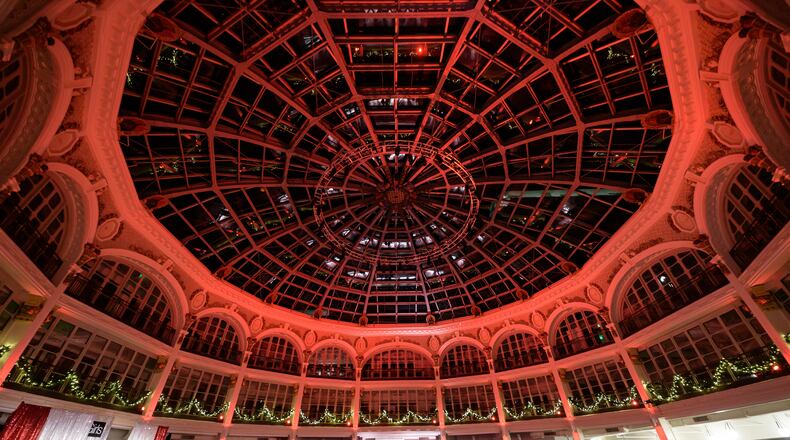Here are 5 takeaways from the report and presentation:
Credit: Tom Gilliam
Credit: Tom Gilliam
TAKEAWAY 1: Numbers show the economic impact is big
Some of the stats:
- $239 million of economic activity in Montgomery, Miami, Clark and Greene counties stemmed from investment in arts and culture
- Event-related spending by art and culture audiences totaled $142.5 million
- 4,490 local jobs are impacted by arts and culture
- Nonprofit arts and culture audiences spend an average of $21.60 per person, per event (not including ticket sales)
- 13,744 volunteers contributed to 397,000 hours, which accounts for $11.6 million in volunteer value
- 88.5 percent of audiences said “this activity or venue is inspiring a sense of pride in this neighborhood or community”
- 88.7 percent of audiences said “my attendance is my way of ensuring that this activity or venue is preserved for future generations”
“The arts are resilient and we are working our way back,” Cohen said. “The arts are about attracting people to the community. People want to participate, engage and scratch that cultural itch. They’re going to do it. They can do it right here in the (Dayton) community or do it somewhere else. So, if you’re a local business, you love this vibrant arts and culture community that we have in the Dayton region. There are so many cultural options, so many art forms, and so much to do.”
TAKEAWAY 2: Dayton had good survey participation
Culture Works joined 373 other communities across the United States and Puerto Rico in the AEP6 study endeavor and collected data in Montgomery, Miami, Clark and Greene counties. Data was from audience intercept surveys at events as well as collected from organizational surveys submitted by individual organizations or collected by Culture Works
There was a participation rate of 51.9 percent from individual organizations and a collected 1,187 audience intercept surveys. Cohen said that is in line with the rest of the nation in terms of participation rates.
“The data shows that investment in the nonprofit arts and culture industry builds the communities where people want to live and work,” said Dorie Watts, director of program operations and advocacy for Culture Works. “It is where entrepreneurs and creative economy businesses are launched and where nighttime economies flourish.
TAKEAWAY 3: Dayton arts contributes to preservation of democracy
Sharon L. Davies, president and CEO of the Charles F. Kettering Foundation, said she viewed the AEP6 study as a chance to “change a community’s understanding of the important impact of the arts which would justify more investments of a community in the arts.”
“Some people’s love languages are economic impact — economic development, economic prosperity,” Davies explained. “Our language at the Kettering Foundation has everything to do with the strength of democracy. And we see them as parts of the same conversation. We love that this has been a report that, nationally, has been developed by Americans for the Arts six times and that our community was involved in providing data that could show the robustness of the arts and culture community that exists here in Dayton.”
Davies praised Americans for the Arts for expanding its reach to ensure underserved populations were represented in the study.
“We’re thrilled that Americans for the Arts has realized they had to broaden their lens to capture the fullness of the arts and cultural community that exists here,” she said. “Because once we do that, there are all kinds of things that could happen not just economic impact and giving this community its due for its economic impact, but also thinking creatively about synergies in a community that are made possible by knowing where these assets actually exist.”
She also said being more strategic about utilizing the gifts of collaboration and partnerships between organizations is a primary means to improving community.
“When we have fuller idea of where those (artistic and cultural) assets are and get creative about partnerships, we can literally change the health of our communities,” Davies said. “This is what citizen engagement looks like.”
Credit: Tom Gilliam
Credit: Tom Gilliam
TAKEAWAY 4: Groups are rebounding from the effects of the COVID-19 pandemic
Audiences at live events decreased during the COVID-19 pandemic for obvious reasons. Attendance habits changed, and “the arts and hospitality industries suffered profound job losses, and billions of dollars were distributed to the arts and culture sector from federal pandemic relief funding such as the CARES Act. What has not changed is the community-based focus of our work,” the study report says.
But arts and culture organizations showed resilience by:
- Moving to virtual and online experiences
- Added outdoor performances
- Creating drive-in events and other innovative options
The arts community became even more of a giving community during the pandemic:
“Forty percent of responding AEP6 organizations reported that, during the height of the pandemic, they expanded services beyond arts and culture in order to address urgent community needs such as collecting and donating supplies, donating facility space as a testing/vaccination site, or helping other organizations and individuals apply for pandemic relief and unemployment benefits.”
TAKEAWAY 5: Outsiders come to Dayton for its events
The activities in Dayton are a big attraction for folks who will travel to the area for them. People who are not local spend twice as much in the region. They are going out for meals before events, spending the night at local hotels and trying out other venues while they are in the area.
“When people attend a cultural event, they often make an outing of it — dining at a restaurant, paying for parking or public transportation, enjoying dessert after the show, and returning home to pay for child or pet care,” states the report. “AEP6 shows that the typical attendee spends $38.46 per person per event, in addition to the cost of event admission. A ZIP code analysis of each of the 224,677 survey respondents shows that a third of attendees (30.1%) traveled from outside the county in which the event took place. Their event-related spending was more than twice that of their local counterparts ($60.57 vs. $29.77).
“What brought those visitors to town? For 77% of respondents, the primary purpose of their visit was to attend that cultural event. When we asked their local counterparts what they would have done if the event where they were surveyed had not been available, 51% said they would have “traveled to a different community to attend a similar arts or cultural activity”— and 64% of nonlocal visitors would have traveled to another community as well. Vibrant arts communities attract visitors who spend money and help local businesses thrive. They also keep resident spending money local — a value-add that few industries can compete with,” the report states.
MORE
To read the study or for more information about Culture Works, visit cultureworks.org.
About the Author





